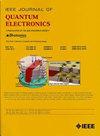High Magnitude Spin-Dependent Shift and Field Enhancement in BaTiO3-Based Plasmonics for Quantum Photonic Applications
IF 2.1
3区 工程技术
Q3 ENGINEERING, ELECTRICAL & ELECTRONIC
引用次数: 0
Abstract
This research investigates the integration of photonic spin-orbit interaction (SOI) with plasmonic phenomenon using Barium Titanate (BaTiO3) as the active material. A remarkable transverse spin-dependent shift (SDS) of量子光子应用中基于batio3的等离子体的高量级自旋相关位移和场增强
本研究以钛酸钡(BaTiO3)为活性材料,研究了光子自旋轨道相互作用(SOI)与等离子体现象的集成。一个显著的横向自旋相关位移(SDS) $838~\boldsymbol {\mu }\mathbf {m}$被证明-大约28倍于观察到的传统等离子体材料,如银(Ag)。研究进一步探讨了共振条件下增强电场与自旋依赖分裂之间的相互作用,发现共振角受到SDS大小和场增强的强烈影响。利用这种增强的基于自旋的相互作用,我们展示了量子光学器件设计的潜力,包括光学微分器和高灵敏度传感器。该微分器结构的共极化(V-V)分量的功率权重为414.96,交叉极化(V-H / H-V)分量的功率权重为0.35。此外,与折射率为1.33的标准等离子体系统相比,基于光子自旋的传感器结构实现了$\sim~52\times $的灵敏度增强。这些发现确立了batio3集成等离子体平台作为量子技术领域先进自旋光子器件的有希望的候选者。
本文章由计算机程序翻译,如有差异,请以英文原文为准。
求助全文
约1分钟内获得全文
求助全文
来源期刊

IEEE Journal of Quantum Electronics
工程技术-工程:电子与电气
CiteScore
4.70
自引率
4.00%
发文量
99
审稿时长
3.0 months
期刊介绍:
The IEEE Journal of Quantum Electronics is dedicated to the publication of manuscripts reporting novel experimental or theoretical results in the broad field of the science and technology of quantum electronics. The Journal comprises original contributions, both regular papers and letters, describing significant advances in the understanding of quantum electronics phenomena or the demonstration of new devices, systems, or applications. Manuscripts reporting new developments in systems and applications must emphasize quantum electronics principles or devices. The scope of JQE encompasses the generation, propagation, detection, and application of coherent electromagnetic radiation having wavelengths below one millimeter (i.e., in the submillimeter, infrared, visible, ultraviolet, etc., regions). Whether the focus of a manuscript is a quantum-electronic device or phenomenon, the critical factor in the editorial review of a manuscript is the potential impact of the results presented on continuing research in the field or on advancing the technological base of quantum electronics.
 求助内容:
求助内容: 应助结果提醒方式:
应助结果提醒方式:


